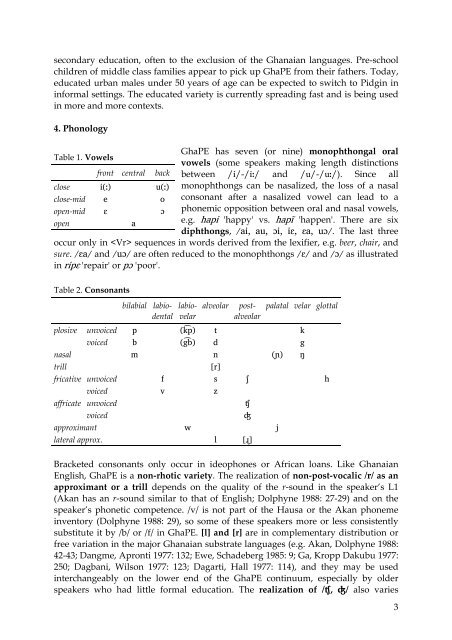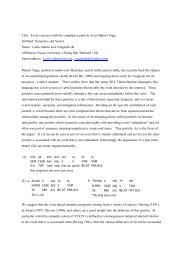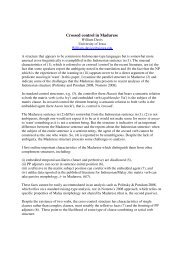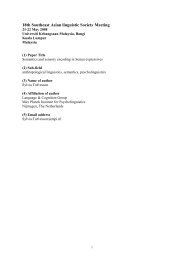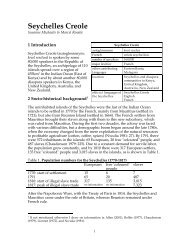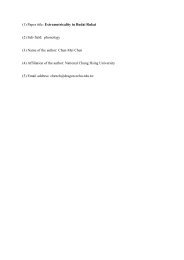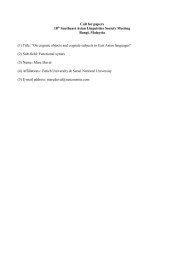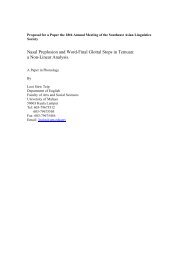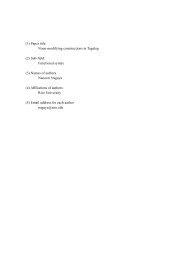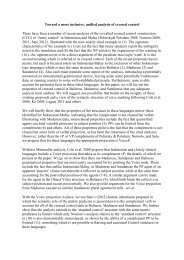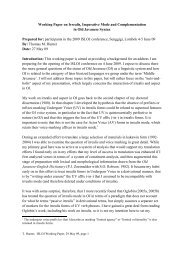Create successful ePaper yourself
Turn your PDF publications into a flip-book with our unique Google optimized e-Paper software.
secondary education, often to the exclusion of the <strong>Ghanaian</strong> languages. Pre-school<br />
children of middle class families appear to pick up GhaPE from their fathers. Today,<br />
educated urban males under 50 years of age can be expected to switch to <strong>Pidgin</strong> in<br />
informal settings. The educated variety is currently spreading fast and is being used<br />
in more and more contexts.<br />
4. Phonology<br />
Table 1. Vowels<br />
GhaPE has seven (or nine) monophthongal oral<br />
vowels (some speakers making length distinctions<br />
front central back between /i/-/iː/ and /u/-/uː/). Since all<br />
close i(ː) u(ː) monophthongs can be nasalized, the loss of a nasal<br />
close‐mid e o consonant after a nasalized vowel can lead to a<br />
open‐mid<br />
open<br />
ɛ<br />
a<br />
ɔ phonemic opposition between oral and nasal vowels,<br />
e.g. hapi 'happy' vs. hapĩ 'happen'. There are six<br />
diphthongs, /ai, au, ɔi, iɛ, ɛa, uɔ/. The last three<br />
occur only in sequences in words derived from the lexifier, e.g. beer, chair, and<br />
sure. /ɛa/ and /uɔ/ are often reduced to the monophthongs /ɛ/ and /ɔ/ as illustrated<br />
in ripɛ 'repair' or pɔ 'poor'.<br />
Table 2. Consonants<br />
bilabial labio‐<br />
dental<br />
labio‐<br />
velar<br />
alveolar post‐<br />
alveolar<br />
palatal velar glottal<br />
plosive unvoiced p (k͡p) t k<br />
voiced b (g͡b) d g<br />
nasal m n (ɲ) ŋ<br />
trill [r]<br />
fricative unvoiced f s ʃ h<br />
voiced v z<br />
affricate unvoiced ʧ<br />
voiced ʤ<br />
approximant w j<br />
lateral approx. l [ɻ]<br />
Bracketed consonants only occur in ideophones or African loans. Like <strong>Ghanaian</strong><br />
<strong>English</strong>, GhaPE is a non‐rhotic variety. The realization of non‐post‐vocalic /r/ as an<br />
approximant or a trill depends on the quality of the r‐sound in the speaker’s L1<br />
(Akan has an r‐sound similar to that of <strong>English</strong>; Dolphyne 1988: 27‐29) and on the<br />
speaker’s phonetic competence. /v/ is not part of the Hausa or the Akan phoneme<br />
inventory (Dolphyne 1988: 29), so some of these speakers more or less consistently<br />
substitute it by /b/ or /f/ in GhaPE. [l] and [r] are in complementary distribution or<br />
free variation in the major <strong>Ghanaian</strong> substrate languages (e.g. Akan, Dolphyne 1988:<br />
42‐43; Dangme, Apronti 1977: 132; Ewe, Schadeberg 1985: 9; Ga, Kropp Dakubu 1977:<br />
250; Dagbani, Wilson 1977: 123; Dagarti, Hall 1977: 114), and they may be used<br />
interchangeably on the lower end of the GhaPE continuum, especially by older<br />
speakers who had little formal education. The realization of /ʧ, ʤ/ also varies<br />
3


